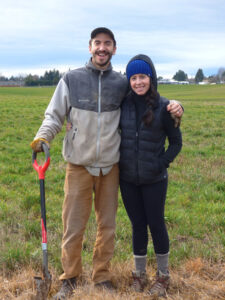
By Melissa Wagoner
Welcoming the new year looked a lot different for Kurt Berning and his fiancé Katie Doyle this year. Instead of party hats and streamers, the couple awoke early, donned their rain gear and headed out into the drizzle to plant over 500 white oak tree seedlings.
“I felt like I could do something for this habitat and I could say thank you for the benefits it’s given my family over the years,” Berning – whose family has farmed their property, located on the outskirts of Mount Angel, for four generations – said. “We’re farming the land but we also want to be the stewards.”
Berning, who graduated from John F. Kennedy High School in 2008, only recently came back to Oregon to work as a Senior Finance Manager for the organization, the Indivisible Project, and to spend time with his parents, Herb and Bernice Berning, on their farm. Part of that time is now devoted to planting trees.
“This has always been a really special area,” Berning said of the property, which is surrounded by grass seed fields and nurseries. “I’m really excited about doing something for the environment locally.”
Initially inspired by a book that chronicled the decline of native white oak trees in the Willamette Valley, Berning enrolled in a six-week course entitled, “Plan for Your Land,” through the Marion Soil and Water
Conservation District.
“We bring in local conservation experts… to teach about various aspects of conservation,” coordinator Sarah Hamilton said of the course, which kicks-off in mid-January. “We start at ground level with soil and water conservation, build up to vegetation, woodlands, riparian areas, agricultural areas, and specific wildlife habitats, and top it off with project prioritization and funding sources. At the end of the class, attendees have worked with us or a partner organization to develop a conservation plan for their property, have prioritized their projects, and maybe applying for funding.”
With the help of Hamilton and representatives of the Pudding River Watershed Council, Berning was able to both construct a plan for a three-acre parcel of his family’s land and apply for a grant, which covered the cost of the seedlings.
“The Landowner Assistance Program is a 50/50 grant,” Berning said of the funding’s stipulations. “But your 50 percent can be your own labor as long as you’re OK putting your time in.”
The trees, which Berning purchased from the Champoeg Nursery, a wholesaler of plants native to the Pacific Northwest, take only a few minutes to plant but will have a lasting effect on the environment.
“As those oaks grow, they will provide food for countless birds, snakes, salamanders, and frogs, among many others,” Hamilton listed.
Once the trees are established, Kurt hopes to remove the remaining ground cover and seed it with native plants commonly associated with oak woodlands and savannah. These include flowers like camas, yarrow, and checkermallow, various native grasses, and shrubs like snowberry, serviceberry, and wild rose. Eventually, he will probably thin the oaks to give them a more natural spacing and add some diversity like madrone and hawthorn.
But Berning’s project isn’t just about replacing displaced habitat it is also about reintroducing a species of tree that historically dominated the landscape of the Willamette Valley.
“Historically, Oregon white oak woodlands and savannas were maintained by frequent fires that burned through the Willamette Valley,” Hamilton described. Many other native trees, like Doug-fir, (which is commonly associated with the Valley), are not as fire resistant and were historically less plentiful on the valley floor. With the decline in fire in the valley, Doug firs and other species have become more abundant… The much taller Doug fir trees shade out the oaks, decreasing oak habitat. That, along with oak removal for agriculture and housing, has had a huge impact on the ecology of the valley. Currently, Oregon white oak woodlands cover approximately three percent of the area that they once did.”
While Berning realizes that planting a few hundred trees on a couple of acres will not replace the thousands that have been lost, he is excited to watch his tiny seedlings grow and flourish, bringing life to what was otherwise a fallow field.
“It’s a long-term goal,” Berning said. He hopes to one day move back to Mount Angel with his own family and try his hand at a bit of market farming.
“I’d like our family to be a part of these projects.”
Discover more information about…
General landowner conservation information:
[email protected]
Restoring Oregon white oak habitat:
www.oregonconservationstrategy.org/strategy-habitat/oak-woodlands www.blam.gov/or/districts/salem/files/white_oak_guide.pdf
www.willamettepartnership.org/oak-accord
Pollinator conservation information:
www.xerces.org/pollinator-conservation
Marion Soil and Water Conservation course information:
www.MarionSWCD.net